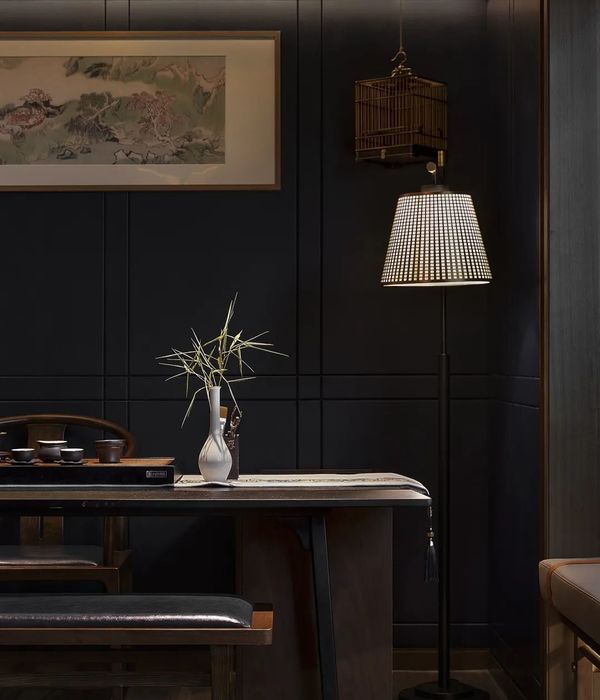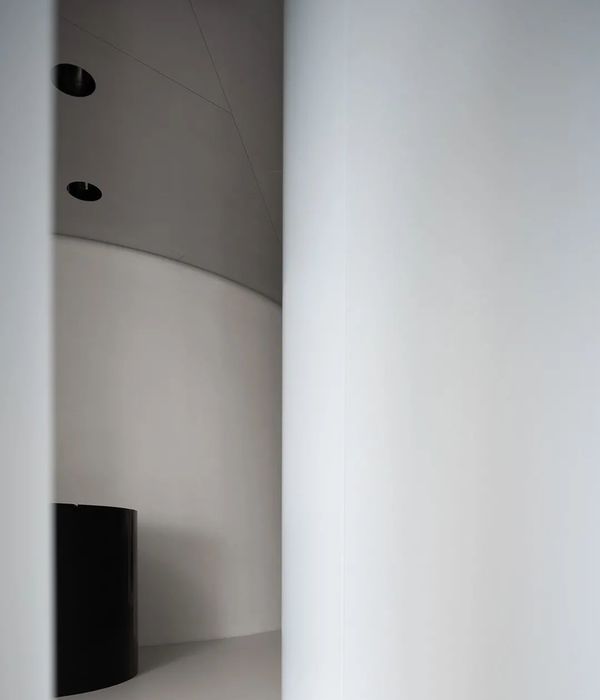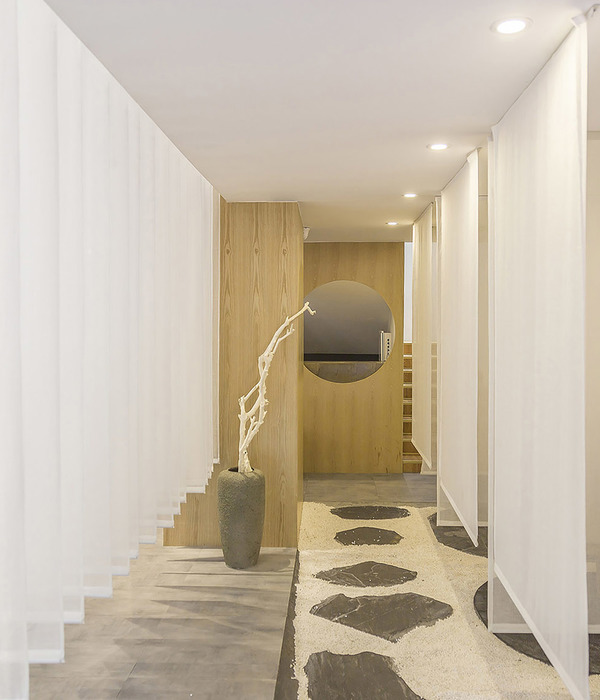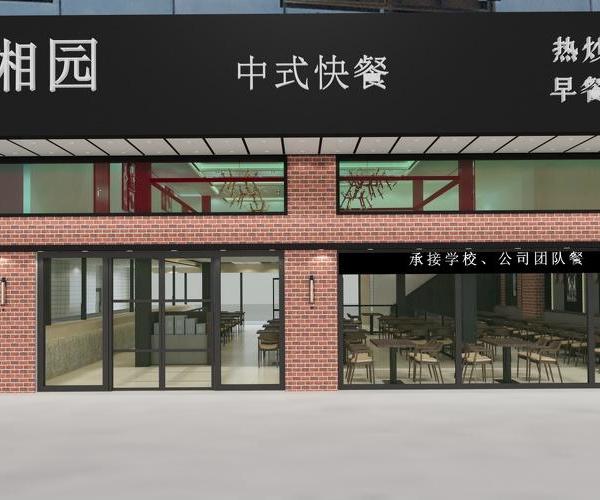- 项目名称:冶春茶社
- 项目地点:无锡
- 项目地址:江苏省无锡市梁溪区清名桥8号
- 项目面积:850m²
- 室内设计:S5 设计 上瑞元筑设计
- 设计总监:范日桥
- 设计团队:朱希,宋圆圆,徐小安,王晶
- 软装设计:之几美学
- 灯光设计:上海格锐照明有限公司
- 施工单位:无锡工作家装饰,无锡米娅商展
- 业主机构:无锡苏春餐饮管理有限公司
- 主要建材:青砖,木饰面,竹帘,艺术玻璃
- 完成时间:2021.6
江南,自古被人们称为人间天堂,这里河湖交错,水网纵横,小桥流水、古镇小城,如诗如画。
Jiangnan, since ancient times was known as a paradise on earth, where rivers crisscross, canals and Bridges, ancient towns, like painting and poetry.
冶春茶社是扬州著名的自然园林式茶社,临河水阁数间,茶肆之间,曲廊相接,相掩于清溪翠柳之中,颇为幽静,宛如身处于诗画之中;而冶春的美食选料严格、制法独特,色香味形,精致细腻而具有浓厚的地方特色,因此深受顾客的喜爱。
Yechun Teahouse is a famous natural garden-style teahouse in Yangzhou, close to the water source and hidden among green willows and streams. The environment is very quiet, as the body in poetry and painting.
| 伫立于运河边的冶春·清和楼
本案的冶春·清和楼坐落于静谧的无锡运河边。无锡古运河是京杭大运河的一段,它北接长江,南达太湖,全长四十多公里,纵贯无锡城区。这里一动与一静相邻,一清透与一厚重相邻。
Yechun Teahouse is located beside the Wuxi Canal. The ancient Wuxi Canal is a section of the Beijing-Hangzhou Grand Canal, connecting the Yangtze River in the north and Taihu Lake in the south. It is more than 40 kilometers long and runs through the urban area of Wuxi.
设计师以中国传统江南水乡村落为蓝图,低层建筑与周围的运河相互映衬,淋漓尽致地诠释了宁静与安逸的意境。
The designer takes traditional Chinese villages in Jiangnan as the blueprint. The low-rise building is set against the surrounding stunning lake view, providing a perfect expression of tranquility and ease.
江南乃至东方的审美都是一种非确定性的审美,是一种朦胧的,而非一眼看透的感觉。
上瑞元筑
CHAPTER 1
雕梁画栋
市列珠玑
| 俯拍冶春·清和楼
从有运河开始,无锡先民就傍河而居,因河设市,以河为生。孕育了独具特色的江南运河水乡文化。
The ancient people of Wuxi lived by the canal, built the city, and lived by the river. They gave birth to the unique culture of the canal town in Jiangnan.
从上方俯瞰过去,冶春·清和楼的建筑总平面呈严谨的中轴线对称式布局,以中式园林为主导,强调建筑的中轴线以及群落感。
Looking down from the top, the overall plan of Yechun Teahouse presents a rigorous symmetrical layout of the central axis, dominated by Chinese gardens, emphasizing the central axis of the building and the sense of community.
冶春·清和楼外观
设计师从中式传统建筑中提炼取了木、砖、瓦等典型材料,从而达到传统和现代的共生与结合。简单的灰墙沙瓦与三角山墙屋顶与周围的白墙黛瓦建筑相互呼应,宛如时光雕琢而成的天然群落。此外,多重庭院和二层天井之间,点缀以柔美的园林水榭,充分印证了中国传统的建筑理念,食客在每个转身处均能感触到新的空间、层次和气氛。
Designers extract wood, brick, tile, and other typical materials from traditional Chinese architecture to achieve the symbiosis and combination of tradition and modernity. The simple gray-walled shingles and gabled roofs echo the surrounding white-walled and tiled buildings, like a natural community sculpted by time. In addition, the multiple courtyards and the second-floor patios interlace with soft garden waterside pavilions, which fully confirm the traditional Chinese architectural concept. Visitors can feel the new space, level, and atmosphere at each turn.
大堂
本案以古建筑为基底,内部植入轻盈柔和的造型形式与精致构架,在传统文人大宅之中融入现代构成语言,将旧的的框架写入新的语言,描绘精致文人生活美学。
This project is based on the ancient building, with light and soft modeling forms and a delicate framework implanted inside. Modern language is integrated into the traditional literati mansion, and the old frame is written into the new language to describe the exquisite literati life aesthetics.
楼梯间望向大堂
进入大堂,一张木制桌几悄然伫立。在这里,新与旧、今与古、现代与经典、时间与空间都高度凝练地重叠着。
Enter the lobby, a wooden table quietly stand. New and old, modern and ancient, modern and classic, time and space are highly condensed overlap.
天花精巧的构架将江南文人美学以解构的形式表达于空间之中,纤巧细致的杆件所组合出的阵列美感,气场庄重又不失飘逸洒脱的灵动。
The structure of the ceiling expresses the aesthetics of Jiangnan literati in the space in the form of deconstruction. The array aesthetic feeling combined with the delicate and meticulous rods is solemn and flexible.
一层餐区概览
室内望向窗外
设计师将现代元素与当代艺术进行结合,不同时代的产物之间的碰撞让我们对过去与现在有一个新的认知,通过形体的表现来体现力量与张力。照明、屏风、墙面、天花,这些地方横平竖直的处理将中式元素展现,使其由艺术异想的慢慢深入而激起更宏大壮阔的空间想象。
The designer combines modern elements with contemporary art. The collision between the products of different times gives us a new understanding of the past and present and reflects strength and tension through the expression of forms. The horizontal and vertical processing of lighting, screen, wall, and ceiling shows Chinese elements and arouses a more grand and magnificent space imagination through the gradual deepening of artistic imagination.
CHAPTER 2
舞低杨柳楼心月
歌尽桃花扇底风
一层大餐区
窗边江南晨景
[一层分析图]游走于城市之中习惯了层楼叠榭的高楼大厦装修精致的办公大楼难免会感慨,秘境难寻。但冶春就是这方能增添红尘岁月,暂时回归平淡生活的去处。
In the high-rises and office buildings of the city, secret areas are difficult to find. However, Yechun Teahouse is to increase the years of the world of mortals, temporarily return to the place of plain life.
一层大餐区
设计师通过典型中式元素与现代化的材质的混搭塑造品位,并通过深色纹实木、素色墙面、水波纹屏风等细节表达营造出隽永而意味深长,增进饮食、交流的氛围。
Designers create the taste by mixing typical Chinese elements with modern materials and create flavor through details such as dark grain solid wood, plain wall, water-corrugated screen to enhance the atmosphere of eating and communication.
一层小餐区
当传统文化与现代美学相遇的那一刻,产生了突破传统淮扬菜空间调性的形式美感,优雅兼具地域特性的空间表达将调动人们的就餐情绪,摩登东方感的现代都市餐厅也将传承文化根基。
When the traditional culture and modern aesthetics meet that moment, a breakthrough in the traditional Huaiyang cuisine space tonality of beauty is produced. Elegant spatial expression with regional characteristics will mobilize people’s dining mood, modern Oriental sense of modern urban restaurant will also inherit the cultural foundation.
天花构架
室内的设计细节上提炼丰富的装饰元素符号,取消繁复的雕刻设计,营造中式意境里的质朴与气韵。立面及隔断材料以现代的玻璃与木饰面为主,充分提升建筑品质感和精细度。并通过现代生产手段,使建筑细节更为精致和完美。
The interior design details extract rich decorative elements symbols, cancel the complicated carving design, create a plain and elegant Chinese artistic conception. Materials of the facade and partition are mainly modern glass and wood finishes. They fully enhance the sense of quality and fineness of the building. Through modern means of production, the architectural details are more refined and perfect.
餐厅内以朴素的素色背景墙去协调深沉安静的木质桌椅,自然和谐,天然去雕饰的纯朴之风弥漫了每个角落。
Wooden tables and chairs are harmonized naturally with plain background walls in the dining room. The simplicity of carved decorations permeates every corner.
原建筑结构
对中国古代文人雅士来说,扇子既是一种身份的象征,又寄寓着个人的文化趣味。特别是折扇,它开合自如,开之则用,合之则藏,进退自如,逍遥自在。连普通百姓也常在家中挂扇子,把扇子视为镇宅之宝。一把小小的扇子,折射出传统文化的丰富多彩。
For ancient Chinese literati beauties, fans were both a symbol of identity and an embodiment of personal cultural interest. Folding fans, in particular, open and close freely, open to use, closed to hide, retreat and retreat freely, free and unfettered. Even ordinary people often hang fans at home and regard them as the treasure of the townhouse. A small fan reflects the richness and diversity of traditional culture.
羽扇纶巾,谈笑间樯橹灰飞烟灭。裁为合欢扇,团团似月明。一把扇子,可以是运筹帷幄,也可以是轻轻低吟。设计师将折扇作为灯具等间距挂在墙上,其背后的灯源作为间接照明,扇子的折痕将灯光散射在墙面上,其影似花,绽放于白墙上,与尽头的雕花窗扇,相互照应,塑造了极美的中式意境。
Interior designers used folding fans as equidistant lamps to hang on the wall, with the lamp source behind them as indirect lighting. The fan’s creases scattered light on the wall. Shadows bloom like flowers on the white wall. Fans and carved window sash shaped a beautiful Chinese artistic conception.
亚克力竹屏风
木构设计浸润着山水的气息,呈现中式木构的简约和宋代家具的风格。透木质感涂漆,及低照度的光源等一系列细部处理手法,透出原始的朴拙感。
The wood design is infused with the flavor of landscape, presenting the simplicity of Chinese wood structure and the style of furniture in the Song Dynasty. A series of detail processing gimmicks such as besmear paint and illuminant gives a clumsy feeling.
| 餐区木构
设计师用新派摩登的手法表达江南意境,用清雅隽美的画风致敬“宋”的美学,将古雅意境融入当代视觉感受,将古风意蕴进行现代形式的演绎。
The designer expresses the artistic conception of Jiangnan with modern technique and pays tribute to "Song" aesthetics with elegant and elegant painting style. He integrates the ancient artistic conception into the contemporary visual feeling and interprets the meaning of the ancient style in modern form.
| 江南意境
坐于靠背椅,就着中式灯具投下的明净灯影,在简洁大方的现代式中式餐桌前就餐,前戏与情绪已酝酿地恰到好处,只待美食入胃。
Sit in the chair, concerning the bright and clean light shadow that Chinese style lamps and lanterns cast, repast before the table of concise and easy contemporary Chinese style, foreplay and mood already ferment ground is proper, wait for gastronomy to enter stomach only.
餐区
列肆招牌,灿若云锦,繁华时光流成了一条悠缓的河。冶春枕河而立,白墙黛瓦,自成街巷,冶春·清和楼紧靠运河,与喧嚣咫尺之遥,却能闹中取静,仿佛置身于时光之外。
Busy time flows into a slow river. Yechun Teahouse is close to the canal. The restaurant is so close to the hustle and bustle, but it can be quiet as if it is outside the time.
古典形式的窗扇徐徐向外敞开,使空间宛如一幅宋代江南茶社画卷,如同行云流水般的移步易境,抽象的美将空间的戏剧化淋漓尽致的表达,人文的情感与表达语言相互融合,将人置身于“情景”之中,感受温润雅致的新派意境。
The window sash in classical form opens outwards, making the space like a Song Dynasty painting of a teahouse in Jiangnan. Abstract beauty dramatizes space incisively and vividly. Humanistic emotion integrates with expression language. The restaurant places oneself in the person "scene" in, experience wen runs refined new school artistic conception.
紧靠运河的座椅
烟花三月下扬州,诗人的心中柳絮如烟、繁花似锦的阳春三月,是扬州最美好的季节。然而枕河而居的人家,临水而建的茶社,则是江南人家真实的写照,捧一杯香茗,品一盘珍馐,一道在水雾萦绕中看如烟的江南氤氲。设计师巧妙地将这一切置于无锡运河边,江南之景跃然纸上。
March is the best season in Yangzhou. The people and the teahouses are the portrayals of people living in Jiangnan. Holding a cup of tea, taste a plate of delicacies, a lingering water mist to see the smoke of Jiangnan dense. The designer cleverly placed all of these on the Wuxi Canal, the scene of Jiangnan on the paper.
CHAPTER3
池上楼台堤上路尽日悠扬飞舞
一层至二层楼梯
[ 二层分析图 ]如果说室内的线条是流淌的河水,那么二层的中庭就有如一尾春风吹拂过大地,用看似轻柔的色彩化做春天里微微吹过的风,吹醒了万物。
If the indoor lines are flowing river, then the atrium on the second floor is like a spring breeze blowing across the earth, using seemingly soft colors to turn into the wind blowing gently in spring, blowing everything awake.
二层中庭
设计师采用天井形式,为室内引入更多自然光线,伴随一天内时间的变化,光影随之在室内尽情嬉戏。而木结构打造的屋脊线,为空间增添了几许自然古朴的味道。
The patio brings more natural light into the interior. Light and shadow change in the interior as the time of day changes. The ridgeline that the wooden structure makes added the taste of how much natural simplicity for the space.
二层中庭
屋檐内外,隔着一层通透玻璃,似乎相互融合,又有一层模糊的界限,在旧式的建筑里加入了新式的元素,这是现代和古代的交织,是古今相融的产物。
Inside and outside the eaves, there is a layer of transparent glass. New elements were added to the old building. It is the interweaving of modern and ancient times, the product of ancient and modern integration.
中庭采用围合式连廊设计,水帘从屋顶内侧坡流入天井,水聚天心。置身水帘中,犹如对弈天地间,营造出一仙意禅境。
The atrium adopts an enclosed corridor design, and the water curtain flows into the patio from the inner slope of the roof. Place yourself in the water curtain, like playing chess between heaven and earth, create a fairy meaning zen house.
二层走廊
二层走廊
不局限于一方庭院,随着长廊前行,对称性的轴线系统愈加明晰,视线的稳定感提前,建筑、室内、景观等设计要素退居其后,成为背景。
It is not limited to one courtyard. As the corridor moves forward, the symmetrical axis system becomes clear. The sense of stability of the sight is advanced. Architecture, interior, landscape, and other design elements retreat behind and become the background.
CHAPTER4
羌管弄晴
菱歌泛夜
包厢门牌
二层联通包厢
进入二层的包厢,这里有着丰富的材料:传统深色棚顶,东方图案装饰,木材,素色饰面等等。照明设计旨在突出这些丰富,创造一个温暖开放的空间。高大天花板上吊垂的灯具也非常引人注目。
The balcony on the second floor has plentiful materials: traditional dark roof, Oriental pattern decoration, wood, plain finishes, and more. The lighting design aims to highlight this richness and create a warm and open space. Light fixtures hanging from the high ceiling are also eye-catching.
二层联通包厢
宋画之美,美在简单、含蓄、谦卑、轻柔的艺术态度。设计师从宋代绘画作品中汲取灵感与色彩基调,将人文情感表达于空间之中,从而使空间氛围及传统又当代,既人文又摩登。
The beauty of Song paintings lies in the artistic attitude of simplicity, implication, humility, and gentleness. Designers draw inspiration and color tone from the Paintings of song Dynasty. The restaurant expresses humanistic feelings to make the atmosphere and traditional space contemporary, both humanistic and modern.
二层包厢
古建筑中飞檐碧瓦的形意,被设计师运用于空间天花的中脊结构上,在古朴白墙的背景下,串联、描摹一幅抽象山水画,与围坐区的屏风画相得益彰,亦与各式精巧摆件另添韵味。
The shape of eaves and blue tiles in ancient buildings are applied to the middle ridge structure of the space ceiling by designers. The background of the simple white wall depicts an abstract landscape painting, and the sitting area of the screen paintings complement each other, but also with all kinds of exquisite furnishing pieces to add charm.
二层包厢
二层的空间中大量应用了斜坡屋顶元素。在中国古代绘画中,倾斜的空间处理手法极为重要,画面比平行空间更具纵深感,更加有想象空间。
Sloped roof elements are used extensively on the second floor. In ancient Chinese paintings, the spatial processing technique of tilt is essential, and the picture has more depth and imagination than parallel space.
包厢夜景
基于丰富灵动的变化,而非一味循旧的传统。在设计包厢时,设计师以自然风物与江南文蕴为起笔,进行场景美学的视觉化表达,实现“不出城廓而获山水之怡,身居闹市而得林泉之趣”的理想情境。
Based on the rich and dynamic change, rather than blindly following old traditions. In the design of this box, the designer to the natural scenery and Jiangnan culture as the starting pen, scene aesthetic visual expression.
包厢细部宣纸、竹木、铁艺、实木,在这里,不同材质之间的碰撞产生新的艺术火花,在绿植的衬托下富有生机。
Chinese art paper, bamboo, iron art, solid wood, the collision between different materials produce new artistic sparks under the background of green plants full of vitality.
斜坡屋顶
设计师以浓墨重彩的力度来描绘包厢的东方氛围,从光影到色彩,从结构到立意,延伸过道的纵深视觉感,实现烟波浩渺而意境悠悠的江南风致。
The designer describes the Oriental atmosphere of the box with the strength of thick and heavy colors. From light and shadow to color, from structure to conception, extending the depth of the corridor visual sense, to realize the Jiangnan style of misty and leisurely artistic conception.
初春的江南万物复苏一切都笼罩着朦朦胧胧的水雾,柳条嫩芽,桃树上花苞点点粉嫩,春雨纷飞,河面上泛起丝丝涟漪,一切都是细腻轻盈之态,而又充满勃勃生机之美。
In early spring, everything in Jiangnan is shrouded in hazy water mist. The wicker sprouts. The peach buds are pink and tender. The spring rain made ripples on the river. Everything is delicate and light yet full of vital beauty.
一层包厢
古典制式的原木家具、意蕴交叠的艺术吊灯、挥毫泼墨的软饰扪布、别具一格的当代挂画、隐逸灵动的植被端景、光影绰约的木艺格栅......设计师以现代手法将游园之趣融入场景的演变逻辑,满足人们各式各样的宴会情境,营造出雅致斐然的东方美学氛围。
Designers use modern techniques to integrate the fun of the garden into the evolution of the scene logic, to meet people’s various banquet situations, and create an elegant Oriental aesthetic atmosphere.
[ 一层平面图 ]
[ 二层平面图 ]项目名称|冶春茶社
项目地点|无锡
项目地址|江苏省无锡市梁溪区清名桥 8 号
项目面积|
850m
室内设计|S5design 上瑞元筑设计
设计总监|范日桥
设计团队|朱希、宋圆圆、徐小安、王晶
软装设计|之几美学
灯光设计|上海格锐照明有限公司
施工单位|无锡工作家装饰、无锡米娅商展
摄 影 师|©YUUUUNSTUDIO、©徐义稳
业主机构|无锡苏春餐饮管理有限公司
主要建材|青砖,木饰面,竹帘,艺术玻璃
完成时间|
2021.6
范日桥/上瑞元筑创始合伙人设计总监/上海事务所负责人
2003 年公司成立伊始,即致力于商业空间设计的探索与实践,于经营理念、设计执行、市场研判等诸方面不断审时应变,追求精准时效,在设计方法论上醉心于本土语言的国际化叙述,并不断锐意创新。建司至今在餐饮、酒店、商业地产、休闲娱乐、商展等业态空间与公共空间均有经典案例呈现,在旧建筑改造、样板房设计、街区业态规划、文化主题空间和城市综合体概念策划等诸多领域佳绩斐然。卓越的设计创造能力与专业的商业空间整合解决能力令公司品牌效应享誉业界,跻身于国内前沿商业设计机构行列。上瑞元筑为百胜、海底捞、星伦多、七欣天、喜粤八号、海味观等客户提供长期战略设计服务,公司目前在上海、无锡各设设计机构,服务范围覆盖全国,在长三角、香港、美国等地区均有长期稳定的客户资源。
上瑞元筑近期案例
和子 SPA 会馆
南京海底捞智慧餐厅
苏州喜粤 8 号餐厅
尚色设计 |融创·春华锦营销中心
贝纳恩设计|| 晥晚深圳·前海恒裕前海金融中心
花生联盟 | 耘林阅府
威实设计 | 唤醒猫咪的时空之旅
{{item.text_origin}}












